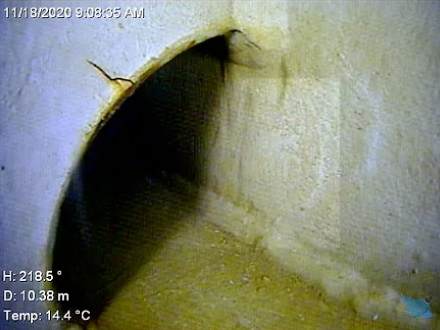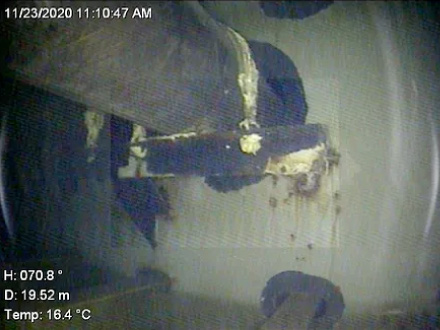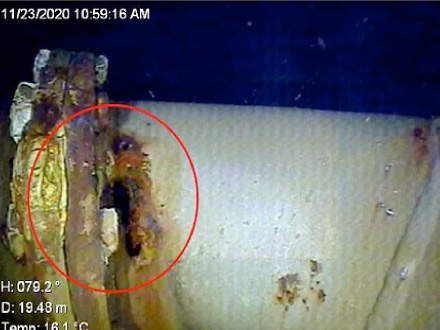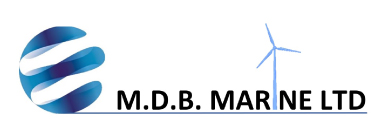Ballast Tanks
All data is captured in 4k which provides the client with clear and detailed footage, which can be paused, zoomed and more.
detailed footage
Ballast Tanks
Using ROVs for ballast tank inspections offers numerous advantages over traditional methods and human entry. Ballast tanks are critical components in ships and offshore structures, used to control stability by adjusting buoyancy. Over time, these tanks are susceptible to corrosion, sediment accumulation, and structural issues, making regular inspections essential to ensure the vessel’s safety and performance. Here’s why ROVs are preferred for ballast tank inspections:
- Safety: Ballast tanks can be hazardous environments due to confined spaces, poor ventilation, and potential exposure to toxic gases. Using ROVs eliminates the need for human entry, reducing the risk of accidents and ensuring the safety of inspection personnel.
- Real-time Data: ROVs are equipped with high-definition cameras, providing real-time visual feedback to operators on the surface. This allows immediate assessment and decision-making during the inspection, enhancing efficiency and response time.
- Ultrasonic Thickness Measurement: Some ROVs are equipped with ultrasonic thickness gauges, allowing them to measure the thickness of the tank’s walls and identify any areas of metal loss or corrosion. This data helps assess the structural integrity of the tank.
- Corrosion Assessment: ROVs can closely inspect the tank’s surfaces for signs of corrosion, rust, or coating degradation. Early detection of corrosion allows for timely maintenance, preventing the issue from escalating and extending the tank’s lifespan.
- Sediment Accumulation: Ballast tanks can accumulate sediment and debris, impacting their efficiency and stability. ROVs can assess the level of sediment and identify potential blockages, allowing for proper cleaning and maintenance.
- Efficiency and Cost-effectiveness: ROV inspections are efficient, reducing the time required for inspections compared to traditional methods. This reduces operational downtime, minimizing financial impact and maximizing vessel utilization.
- Documentation: ROVs can record video footage and capture images during inspections, providing a visual record of the tank’s condition. This documentation is valuable for compliance with regulations and in-depth analysis.
- Preventive Maintenance: Regular ROV inspections enable proactive maintenance, identifying issues at an early stage. This approach helps prevent unexpected failures, reduces repair costs, and improves the overall reliability of the vessel.
- Environmental Impact: By using ROVs, the need for divers and potential discharges of contaminants into the water is minimized, contributing to environmental preservation and compliance with environmental regulations.
In conclusion, using ROVs for ballast tank inspection ensures safety, thorough coverage of the tank’s interior, real-time data feedback, and early detection of corrosion or structural issues. The efficiency, cost-effectiveness, and ability to perform preventive maintenance make ROVs an indispensable tool in maintaining the integrity and safety of ballast tanks in ships and offshore structures.
If your asset’s ballast tanks are requiring an inspection, let us show you how you can save time and currency. Click the “contact us” button and a representative will be in touch.
- Critical areas – 1 day, including reporting.
- Full class – 7 days including reporting.


specialist inspection
All footage is captured in 4k which provides the client with clear and detailed footage, that if required can be paused, zoomed and specific targets can be seen clearly.
There have been occasions where a more specialist type of inspection is required on selected areas. For example, these can be:
- Ballast pipe thickness checking.
- Close visual inspection under the elephants’ foot.
- Stern tubes, J tubes and associated pipework.
- Sound pipes.
COST EFFECTIVE
Using an ROV in a ballast tank is cost-effective due to its ability to minimize operational downtime and reduce labour costs. ROVs can efficiently access confined spaces without human entry, eliminating the need for rope access safety concerns or tank draining, which saves time and resources. Real-time data and high-definition cameras allow immediate assessment, enabling timely maintenance and preventing expensive repairs due to early detection of corrosion or structural issues. Additionally, the comprehensive inspection coverage ensures a thorough evaluation, optimising preventive maintenance strategies and extending the tank’s lifespan, thus providing long-term cost savings and maximising vessel utilisation
To carry out any works in ballast tanks would require 1 x ROV and 2 technicians. This is cost effective, low risk method and faster than the traditional rope access method. Any indications that are noted at time of the inspection and monitored in a timely manner, until such times where the repairs are required.
- Personnel and systems can be mobilised at a moments notice for any urgent queries.

